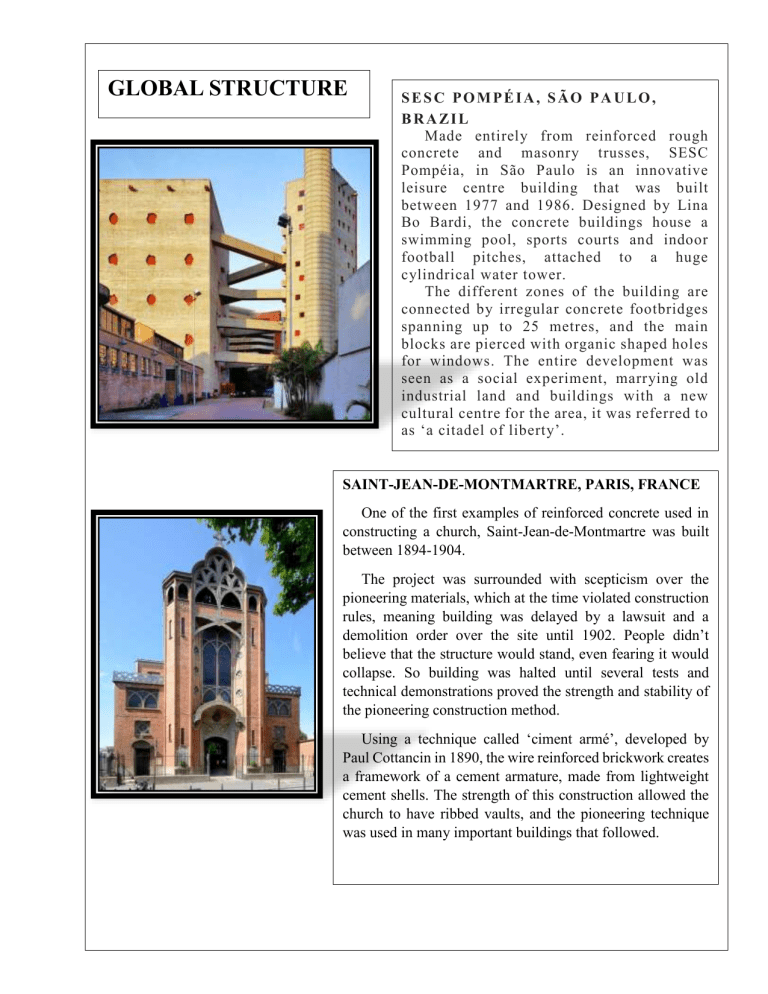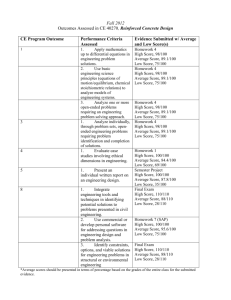
GLOBAL STRUCTURE SESC POMPÉIA, SÃO PAULO, BRAZIL Made entirely from reinforced rough concrete and masonry trusses, SESC Pompéia, in São Paulo is an innovative leisure centre building that was built between 1977 and 1986. Designed by Lina Bo Bardi, the concrete buildings house a swimming pool, sports courts and indoor football pitches, attached to a huge cylindrical water tower. The different zones of the building are connected by irregular concrete footbridges spanning up to 25 metres, and the main blocks are pierced with organic shaped holes for windows. The entire development was seen as a social experiment, marrying old industrial land and buildings with a new cultural centre for the area, it was referred to as ‘a citadel of liberty’. SAINT-JEAN-DE-MONTMARTRE, PARIS, FRANCE One of the first examples of reinforced concrete used in constructing a church, Saint-Jean-de-Montmartre was built between 1894-1904. The project was surrounded with scepticism over the pioneering materials, which at the time violated construction rules, meaning building was delayed by a lawsuit and a demolition order over the site until 1902. People didn’t believe that the structure would stand, even fearing it would collapse. So building was halted until several tests and technical demonstrations proved the strength and stability of the pioneering construction method. Using a technique called ‘ciment armé’, developed by Paul Cottancin in 1890, the wire reinforced brickwork creates a framework of a cement armature, made from lightweight cement shells. The strength of this construction allowed the church to have ribbed vaults, and the pioneering technique was used in many important buildings that followed. THE PENTAGON, VIRGINIA, USA Built in record time, in just 16 months between September 1941 and January 1943, The Pentagon is a five-sided building (hence the name!) made of 435,000 cubic yards of reinforced concrete. Designed by George Edwin Bergstrom, a huge volume of foundation work needed to be carried out before construction of the building could begin. 4.2 million cubic metres of dirt and 41,492 concrete piles were needed to support the foundations. Housing the headquarters of the US Army, Navy and Air force, the site covers 29 acres and roughly 344,000 square metres of usable floor space, and remains one of the world’s largest office buildings in the world to date. LOCAL STRUCTURE OLSEN BUILDING The first building in Manila to use steel mesh reinforced concrete was the Olsen Building at the corner of Calle Escolta and Calle Nueva (Yuchengco street today). It was built in 1906 by the Manila Construction Company. The building housed several companies in its long history, such as the Kiosko Habanero, and the Hamilton Fashion Company. CULTURAL CENTER OF THE PHILIPPINES Structures such as the Cultural Center of the Philippines is made of reinforced concrete that will stand the rest of time. Now Reinforced Concrete is one of the most widely used construction materials in modern history. Concrete and steel acomplement each other. While plain unreinforced concrete is relatively brittle and extremely poor to withstand stress, steel or reinforced steel on the other hand, form a bonding strength that resist tensile forces and form a strong bond together with concrete that is able to resist applied forces and eventually acting as a singular structural element. PHILIPPINE ARENA The Philippine Arena Project is a large domed roof structure. The arena volume is significant, with 227 m × 179 m ellipse shaped space standing, which is the largest non-column arena in the world. Reinforced concrete is used for the bowl structure and main seismic resisting system is considered as dual system STRUCTURAL NOTES

